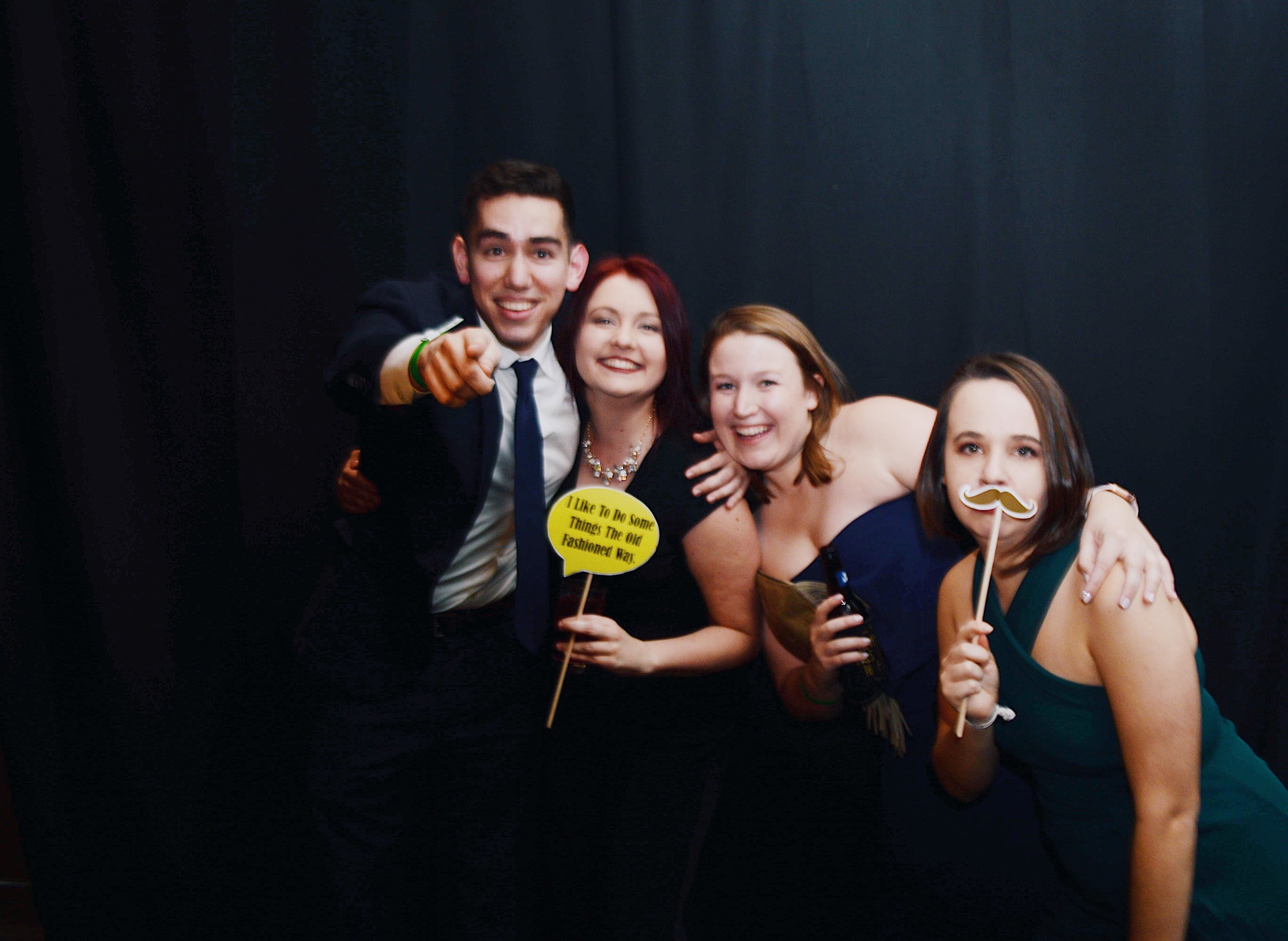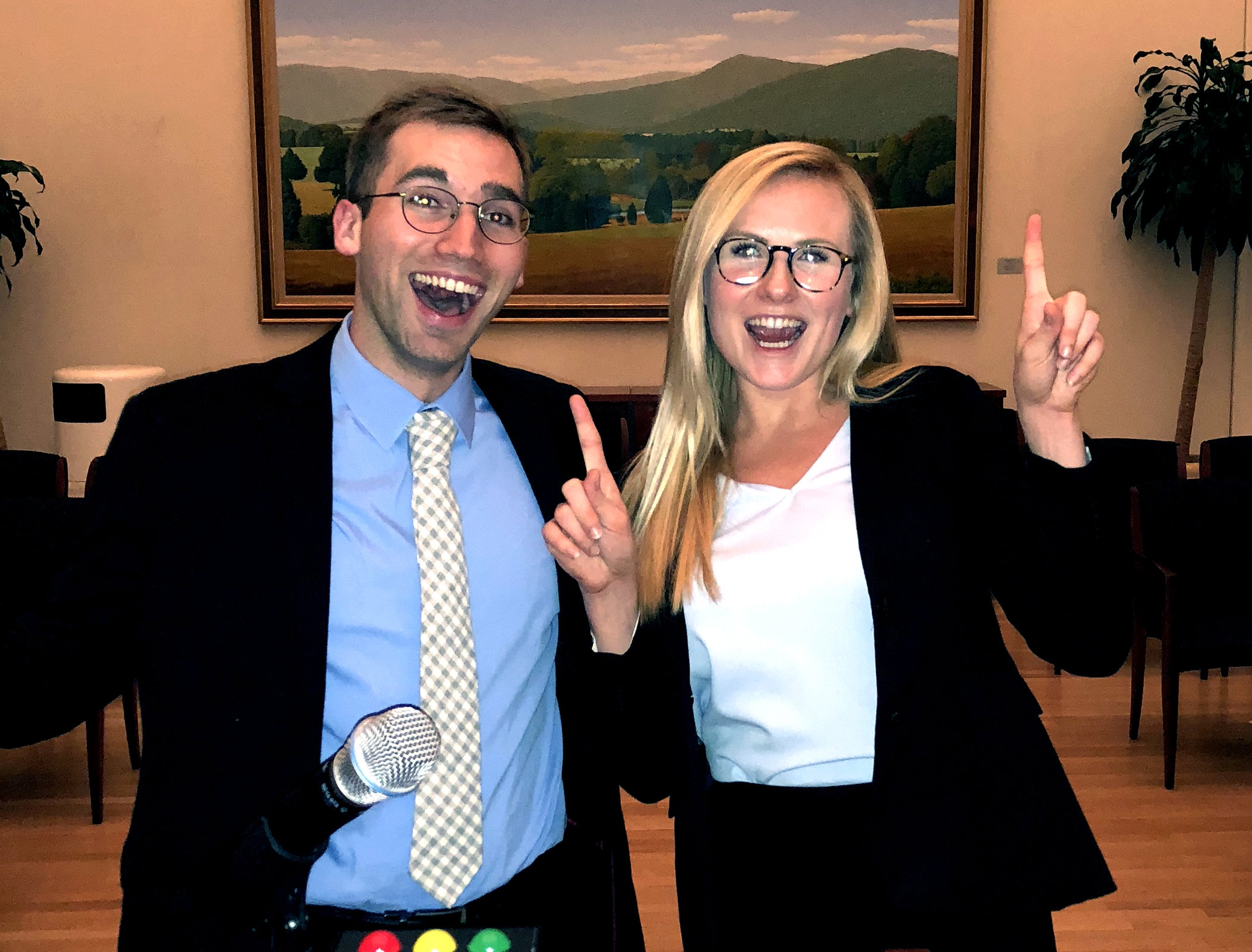New and old SBA officers gathered at the Bebedero for a celebratory meal. L-R: Frances Fuqua ’19, MacLane Taggart ’19, Jasmine Lee ’20, Julia Wahl ’19, Rachel Staub ’20, Trevor Quick ’20, Katherine Janes ’21. Photo courtesy F. Fuqua.
By Sam Pickett ’21 News Editor
New SBA Leadership Seeks Transparency, Diversity, and Community
I must admit that the first fifteen minutes of writing this article were spent looking up funny quotes about democracy. I wanted to seem witty, like my esteemed colleague Jacob Jones ’21 in his coverage of Barrister’s, but I couldn’t find the right quote. They were all cynical, and that simply isn’t my personality, especially given the fact that I just won an uncontested election to be the News Editor for the Law Weekly. As I followed the SBA candidates along the campaign trail, I have come to feel a certain pride in the direction the organization seems to be heading and the priorities its members seem to embody. As we look forward to a new year of socials, bar reviews, and other events, I hope to show the UVA Law community what we can expect.
Big Themes
Transparency: It is only right to begin with the initiative that dominated the election cycle. Newly elected SBA President Jasmine Lee ’21 has cited transparency as her primary initiative, emphasizing the need to make SBA more accessible to the student body, and for students to “know that SBA wants to hear from them.” While meetings are open to the general public and minutes are posted online, President Lee hopes to continue conversations with the new student government to make sure that students feel their government represents their interests. Most of the new 2L Senators share Lee’s goals; four of them mentioned the need for transparency in their candidate statements. 2L Senator Christina Luk is pushing for SBA to more regularly update its website1 with its initiatives and to possibly send out a “State of the SBA” summary each semester. Senator Luk’s new colleagues Eli Jones, Savanna Williams, and Page Garbee, all class of 2021, made transparency a similarly important part of their campaign platforms by emphasizing that SBA should not be operating behind closed doors and should be talking to the student body to identify certain goals and priorities.
This need for transparency includes the organization’s finances; newly elected Treasurer Trevor Quick hopes to make the budget available for student viewing as an important measure of accountability and student involvement.
Diversity: A number of SBA’s newest officers chose to focus on diversity. In one of the most illuminating presentations given at the debate, new Honor Committee Representative Stephen Paul ’21 brought attention to international students under the honor system. He called for more direct engagement between “Honor” and international students, such as intermediaries for students who may not feel comfortable approaching their professors and TAs. New 2L Senator Will Hinton also hopes to use his role to promote diversity, emphasizing the need to make students who belong to historically marginalized backgrounds comfortable voicing their concerns. Senator Luk plans to meet with leaders from affinity groups around North Grounds to identify areas where SBA can offer support. In fact, a large part of why Senator Luk ran for office was because of this year’s Diversity fair, saying:
At the event, the diversity tables had been set up outside in Spies Garden while SBA hosted its own social inside ScoCo. The setup was unfortunate, because SBA had effectively barricaded half the doors leading out to Spies Garden with its own food tables. Given the relative darkness and chill of late evening, attendance at the Fair was predictably low. One memorable guy did make it out to the APALSA table––he came to grab a plate because SBA had run out. Standing out in the cold with the other affinity and diversity groups, I felt a great impatience for change. I think that SBA lacks awareness of the struggles that diverse students face on campus.
SBA as an Intermediary: Another commonality among SBA’s new officers is an understanding of the organization as an intermediary between the Law School and the student body. President Lee specifically defines the SBA as “the body that can be an intermediary and speak with administration on an issue, work to address student complaints, and have a voice with Main Grounds.” As the former Secretary of SBA and FYC representative during her 1L year, President Lee has had the opportunity to speak with a great number of students and faculty—a characteristic I believe will make her an excellent ambassador for students’ concerns. 2L Senator Colin Lee (no relation to Her Majesty––the President) sees SBA similarly, in that it “facilitates a balanced dialogue between different interest groups in the school” and “brings [SBA] members together in order to address any concerns that are brought to the organization’s attention.” Senator Lee also wants to make SBA an intermediary between the Law School and the community by reaching out to charities and organizations in the larger Charlottesville community.
3L Senator Read Mills also sees SBA as an intermediary, but on a more practical level. He wants to help student organizations turn their ideas into actions by applying for funding and connecting with other organizations seeking to plan similar events. Mills has been an important contributor to the SBA’s social planning, along with “all-stars” Sara Phipps’20, Tazewell (“Taz”) Jones ’20, Jasmine Lee ’20, Ryan Poche ’19, and Ben Elron ’20, which has given him considerable experience in pulling the Law School together around the joys of food and drank [I know this is a serious article, but I just love phrasing it as drank.]
The Law Weekly looks forward to seeing this group of leaders push for transparency, diversity, and accessibility to the student body. And, most importantly, I look forward to seeing how many free meals SBA provides in the coming year.
Bonus Quiz: Match the SBA Officer to their Bodo’s Order
A) Read Mills
B) Jasmine Lee
C) Collin Lee
D) Christina Luk
1. Plain bagel, egg, and cheddar cheese
2. Garlic bagel with herb cream cheese
3. Toasted onion bagel with scrambled egg, cheddar cheese, and “crisp bacon”
4. Everything bagel with lox and cream cheese
Answers: A(4) ; B(1) ; C(3) ; D(2)
----
shp8dz@virginia.edu














